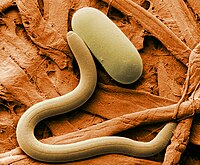
Photo from wikipedia
The soybean cyst nematode (SCN), Heterodera glycines Ichinohe (Phylum Nematoda), is a major pathogen of soybean. It causes substantial yield losses worldwide and is difficult to control because the cyst… Click to show full abstract
The soybean cyst nematode (SCN), Heterodera glycines Ichinohe (Phylum Nematoda), is a major pathogen of soybean. It causes substantial yield losses worldwide and is difficult to control because the cyst protects the eggs which can remain viable for nearly a decade. Crop rotation with non-host crops and use of biocontrol organisms such as fungi and bacteria offer promising approaches, but remain hampered by lack of knowledge of the biology of nematode parasitic organisms. We used a high-throughput metabarcoding approach to characterize fungal communities associated with the SCN cyst, a microenvironment in soil that may harbor both nematode parasites and plant pathogens. SCN cysts were collected from a long-term crop rotation experiment in Southeastern Minnesota at three time points over two growing seasons to characterize diversity of fungi inhabiting cysts and to examine how crop rotation and seasonal variation affects fungal communities. A majority of fungi in cysts belonged to Ascomycota and Basidiomycota, but the presence of several early diverging fungal subphyla thought to be primarily plant and litter associated, including Mortierellomycotina and Glomeromycotina (e.g., arbuscular mycorrhizal fungi), suggests a possible role as nematode egg parasites. Species richness varied by both crop rotation and season and was higher in early years of crop rotation and in fall at the end of the growing season. Crop rotation and season also impacted fungal community composition and identified several classes of fungi, including Eurotiomycetes, Sordariomycetes, and Orbiliomycetes (e.g., nematode trapping fungi), with higher relative abundance in early soybean rotations. The relative abundance of several genera was correlated with increasing years of soybean. Fungal communities also varied by season and were most divergent at midseason. The percentage of OTUs assigned to Mortierellomycotina_cls_Incertae_sedis and Sordariomycetes increased at midseason, while Orbiliomycetes decreased at midseason, and Glomeromycetes increased in fall. Ecological guilds of fungi containing an animal-pathogen lifestyle, as well as potential egg-parasitic taxa previously isolated from parasitized SCN eggs, increased at midseason. The animal pathogen guilds included known (e.g., Pochonia chlamydosporia) and new candidate biocontrol organisms. This research advances knowledge of the ecology of nematophagous fungi in agroecosystems and their use as biocontrol agents of the SCN.
Journal Title: Frontiers in Microbiology
Year Published: 2018
Link to full text (if available)
Share on Social Media: Sign Up to like & get
recommendations!